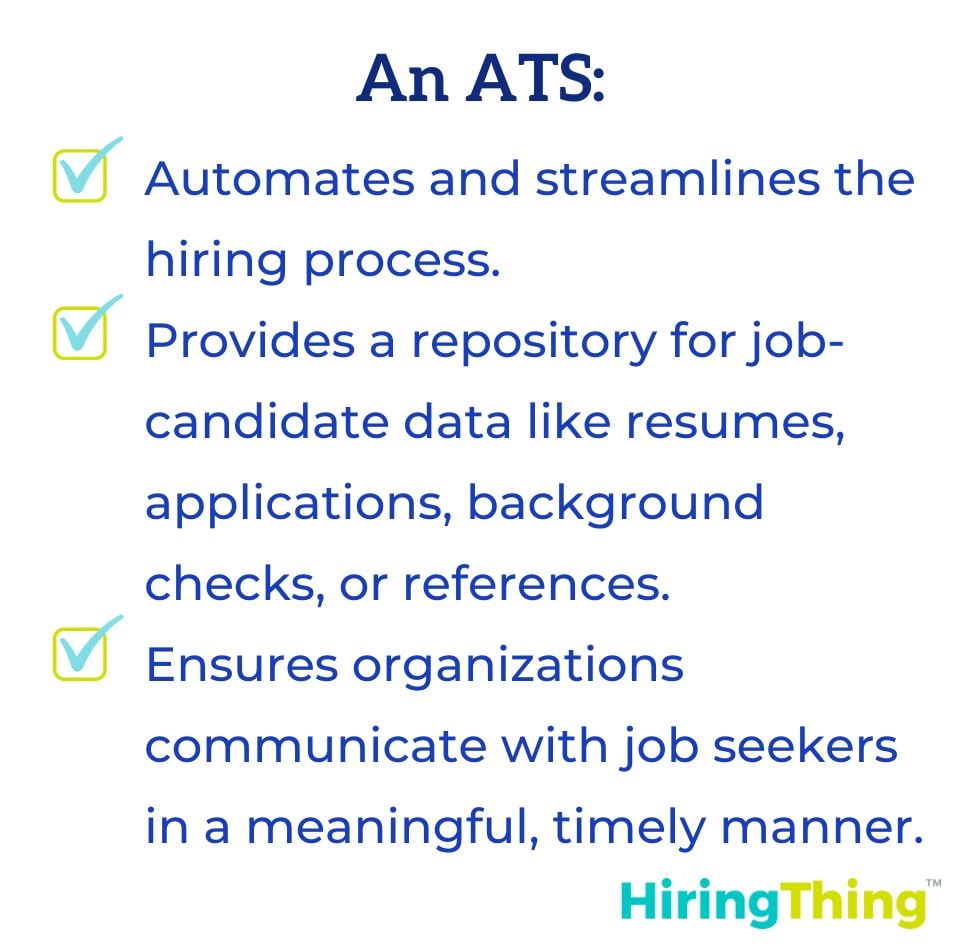Applicant Tracking Systems Aren’t Excluding Job Applicants—People Are

We dismantle the popular claim that applicant tracking systems automatically reject 75% of resumes, arguing that the statistic is misleading and unsupported by credible evidence. Instead, it shows that hiring outcomes are driven by human decisions and hiring practices, with ATS software serving as a tool—not a gatekeeper—to streamline recruitment.
Summary
- The widely cited claim that “75% of resumes are never read by a human” traces back to a defunct company and has been professionally debunked by HR experts and consultants.
- Applicant tracking systems do not autonomously reject candidates; they organize, sort, and filter applications based on criteria defined and managed by people.
- Reputable data shows ATS software improves hiring outcomes, with 94% of HR professionals reporting a better hiring process after adoption.
- Studies often blamed on ATS bias (such as Harvard Business School’s Hidden Workers) actually highlight flawed human-defined hiring criteria, not automated decision-making.
- The persistence of the “evil ATS” myth benefits resume services and obscures the real issue: organizations must rethink outdated, exclusionary hiring practices to attract diverse and qualified
The Myth of the Evil ATS
75% of resumes—that’s 3 out of 4 of all job applications—are never read by a human. That’s the headline of a 2019 CNBC piece that guarantees to help readers “beat the bots.” The body of the article alerts you that, in this case, bots mean an applicant tracking system (ATS), the software 98.5% of Fortune 500 companies and 75% of recruiters and hiring professionals use to automate, streamline, and strengthen their recruiting process. The CNBC article attributes this statistic to job services firm Preptel. It’s an oft-repeated statistic you can find Yahoo News, and CIO articles, as well as countless pieces of marketing collateral, consistently with an anti-ATS lean—CNET included the statistic in their article “Automated hiring software rejects millions of qualified job applicants by mistake.”
.jpg?width=1920&name=Blog%20Pull%20Quote%20Template%20-%201920x1080%20(9).jpg)
But applicant tracking systems don’t reject millions of qualified job seekers. And despite its ubiquity in ATSs-are-the-bad-guy content,“75% of resumes are never read by a human” is misleading at best and patently untrue at worst. It goes against everything we here at HiringThing know about HR technology, namely that there are modern, updated statistics from reputable sources that show how ATS usage positively impacts the hiring—excluding 75% of resumes is not a positive impact on anyone’s recruiting.
According to Capterra, 94% of HR professionals who use an ATS say it’s improved their hiring process—we’re confident that 94% of HR professionals wouldn’t rate ATS usage that highly if they felt they were losing qualified candidates.
What an ATS Does
The average job posting gets 250 applications. An ATS is human resource software that helps companies quickly and efficiently screen, audit, and organize those applications through parameters the company sets.

The software can also help candidates and companies schedule interviews, skills tests, or questionnaires. Applicant tracking systems are designed to improve and optimize the hiring process.
Do you know what causes qualified candidates to self-exclude themselves from jobs? Overly long, complicated job applications. According to CareerBuilder, 60% of job seekers will give up on an application midway through if it’s too long or complex. An ATS can help organizations streamline their application process and increase the number of qualified candidates they can interview.
Applicant Tracking Systems Are Run by People
“The ATS is basically a giant database,” says Amy Miller in her YouTube video "The Truth About the ATS" (it’s not what you think). Miller is a recruiter who’s worked for Amazon and Google and runs the YouTube channel “Recruiting in Yoga Pants.” “It’s run by humans,” she continues about applicant tracking systems, “the information is entered by people, the statuses are updated by people, and everything that goes right and wrong is because of people.”
.jpg?width=1920&name=Blog%20Pull%20Quote%20Template%20-%201920x1080%20(15).jpg)
Miller’s video is informative, and though light in tone, she’s clearly frustrated with those who blame applicant tracking systems for excluding job applicants. “The idea that the ATS is this mythical, genius, AI-infused tool is crazy. Anyone who has been in an ATS and has used it for work is laughing at this idea. It’s so ridiculous,” she says.
“75% of Resumes are Never Read by a Human” is Professionally Debunked
Human Resources Consultant Christine Assaf was frustrated by the vilification of applicant tracking systems as well. She found the “75%” statistic suspect, so decided to track down the origins of the stat, which she documented in an excellent blog post titled “Your Job Application Was Rejected by a Human, Not a Computer.” The stat originated, seemingly devoid of any study, survey, or context, from a job-services company that hasn’t been in business for seven years. “Yes, that’s right,” Assaf writes, “Preptel, the company who provided amazing, job seeker resume-writing and a totally unbiased study went out of business in August 2013.”
We were so impressed by the thoroughness of Assaf’s post, a deep dive into how stats can be manipulated and then become accepted as common knowledge, that we reached out to ask what spurred on her investigation. She was gracious enough to write us back,
“The reason I started researching the myth was because I'd heard the comment, ‘ATS systems reject 75% of resumes,’ repeated multiple times by various job coaches and felt compelled to investigate the actual research,” Assaf says. “Of course, as suspected, I didn't find any conclusive statistical evidence of this premise. Merely conjecture. It's simply not true that ATS systems auto-reject. They may weigh, or sort, or filter, but any recruiter will tell you that most if not all resumes are reviewed by a person.”
.jpg?width=1920&name=Blog%20Pull%20Quote%20Template%20-%201920x1080%20(14).jpg)
Applicant Tracking Systems Don’t Reject Resumes. People Do.
Applicant tracking systems weigh, sort, and filter, but it’s people that do the reviewing. It’s also people that do the rejecting. While many of the articles that cite this now disproven “75% of all resumes are never read by a human” stat will mention robots or algorithms, we can assure you that isn’t the case. Applicant tracking systems are built to help people streamline hiring. They aren’t a magic tool that does the hiring themselves. There is no algorithm. There are parameters and customized hiring workflows, but those are set by people using the ATS, not the software.
Debunking ATS Myths, Continued
While they never reference the disproven 75%-stat, A September 2021 Wall Street Journal (WSJ) article titled “Companies Need More Workers. Why Do They Reject Millions of Resumes?” attempts to once again blame applicant tracking systems for qualified job seekers not getting interviews. “Automated hiring systems are excluding many people from job discussions at a time when additional employees are desperately needed,” the article’s sub-headline reads.
“Companies are desperate to hire,” the WSJ writes, “and yet some workers still can’t seem to find jobs. Here may be one reason why: The software that sorts through applicants deletes millions of people from consideration.”
The WSJ article heavily references a Harvard Business School (HBS) study titled “Hidden Workers: Untapped Talent.” They report that a large percentage of the companies who participated in HBS’s study—49%—chose to eliminate candidates whose resumes had employment gaps of six months or longer. The article points out how this “resume gap scan” eliminates qualified veterans, working mothers, immigrants, caregivers, military spouses, etc. It’s a valid point, but they’re once again misconstruing the point: it’s not the software arbitrarily deleting these candidates from consideration—it’s the companies using the ATS who decided to use this resume-gap parameter to screen applicants.
The WSJ makes a valid criticism of this screening decision, but the article spends more time on “algorithms” than it does interrogating why companies hurting for qualified job applicants are arbitrarily deciding certain qualified job applicants don’t matter. Don’t blame the ATS. This was a human error—maybe it’s time those people rethought their hiring processes to be more inclusive.
When disability-rights activist David M. Perry investigated arbitrary hiring barriers for an article, he found that 60% of higher education jobs included “must be capable of lifting 25 pounds.” He found this “qualification” peculiar since higher-education jobs aren’t known for their manual labor—more often than not, arbitrary qualifications are what’s excluding perfectly qualified job applicants from landing interviews.
Human Error is Excluding Valuable Job Candidates
The Harvard Business Review study made the media rounds this fall. It was cited in many pieces, typically with the same blame-the-ATS-bend as the WSJ piece. “Report: Applicant tracking systems may exclude whole segments of candidates,” is an HR Dive headline. Citing the Harvard Business School study, this piece starts by saying that,
While applicant tracking systems are "vital" to the work of recruiters, ATS algorithms could be responsible for excluding whole segments of viable candidates, according to a report from the Harvard Business School and Accenture. Of employers surveyed, 88% said that qualified, high-skilled candidates were rejected outright from the hiring process because they did not exactly match the hiring criteria.
The article's title combined with this passage makes it seem as if the HBS study would make a case that applicant tracking systems were the big bad automated technologies killing the dreams of job seekers everywhere, right? Hardly the case. Much as Assaf did a deep dive into the 75% statistic, we did a deep dive in the “Hidden Workers: Untapped Talent” study. The study’s executive summary reads,
"Companies are increasingly desperate for workers. As they continue to struggle to find people with the skills they need, their competitiveness and growth prospects are put at risk. At the same time, an enormous and growing group of people are unemployed or underemployed, eager to get a job or increase their working hours. However, they remain effectively “hidden” from most businesses that would benefit from hiring them by the very processes those companies use to find talent."
As suspected, the study isn’t about how automation and robots exclude qualified candidates. It’s about how organizations must rethink their hiring processes.“While technology is important,” the study says, “it is the active management of leaders, enabled by technology, data, and digital nudges that change outcomes.”
Rethink Your Hiring Decisions
You can read the study in its entirety (and if you have the time, we’d recommend it!), but to ensure nothing else got misinterpreted, we reached out to Manjari Raman, Program Director Young American Leaders Program at Harvard Business School, and one of the authors of the study. "Is it hiring technology or the improper use of hiring technology that ends up excluding the hidden worker?" we asked Raman. Here’s her response:
"At the end of the day, the technology we have is the technology we, as humans, choose to build. Very often the biases perceived in technology are nothing more than human biases that have been hard-wired into the technology. As we adopt more and more technology, we have to exert more and more vigilance on how to break past vicious cycles in hiring practices and implement new virtuous cycles. Only then can organizations create a diverse workforce and find the talent they need. To make the technology smarter, first humans have to make smarter decisions and choices."
HiringThing partner, Titan ATS, is building recruiting diversity on top of our platform.
Raman’s explanation makes sense. Technology doesn’t make choices. People do. And it seems once you get past the clickbait headlines, the media understands that—despite beginning with the inflammatory headline about ATS exclusions, further down, the HR Dive piece says, “To ameliorate the issue, the report suggested employers shift ATS filters from ‘negative’ to ‘affirmative.’ For example, instead of filtering out candidates that do not have a particular degree or who have a gap in their employment history, platforms should be configured to search for candidates that have select skills and experiences to fulfill core requirements.”
We created The HiringThing Guide to Increasing Your Applicant Traffic to help organizations reimagine their approach to recruiting.
Blaming Technology is Easy, but Wrong
.jpg?width=1920&name=Blog%20Pull%20Quote%20Template%20-%201920x1080%20(13).jpg)
Why, then, is the myth of the big-bad ATS perpetuated? Assaf has some thoughts on this.
“Career service industries, resume writers, and other professional career authorities out there really want you to believe that a computer is rejecting you and only they can help. So they perpetuate this statement in an attempt to sell their services,” she writes—the resume-improvement market is estimated to be worth $268 million.
Assaf also believes vilifying the ATS is more palatable for readers and consumers, writing, ” the idea that our application was rejected because of ‘computer error’ sounds way better than we lacked the basic job requirements, lacked, experience, or neglected to tailor our resume to the job posting keywords.” We’d hazard a guess that applies to organizations, too—rethinking your entire hiring strategy takes time, effort, and a lot of self-reflecting on our own biases, whether they be implicit or explicit. Blaming technology is easy.
Many companies, including Hilton, Penguin Publishing, Google, and IBM, have been dropping college-degree requirements from posted jobs to diversify their candidate pools. That’s the kind of thinking that will help hiring technology increase applicant traffic. Do your job postings need 3-5 years of experience? Is a degree necessary? Must a candidate have experience in a niche field? These questions can help organizations audit stagnant hiring strategies. Need more ideas? Check out The HiringThing Guide to Increasing Your Applicant Traffic and start to reimagine your recruiting.
Customize Your ATS to Deliver the Best Qualified Job Candidates
As we’ve established, human error is the main culprit for organizations excluding qualified candidates. Sometimes it’s due to outdated hiring strategies and job posting caveats. Sometimes, it can also be due to not knowing how to properly utilize the technology built to make things easier (which is why all HiringThing users are privy to our Support Beyond Compare™).
A cookie-cutter ATS can occasionally hamper an organization that has specific hiring needs too. However, a private label applicant tracking system—often incorrectly referred to as a white label applicant tracking system (they are similar, but there are a few subtle yet key differences)—can be customized to fit the specific hiring needs of your organization or of the customers you serve. Learn more about what a private label ATS entails or request a demo.
Related Resources
- Ten Reasons All Businesses Can Benefit from Applicant Tracking Systems
- The HiringThing Guide to DEI Recruiting
- What is a Private Label Applicant Tracking System
- Workplace Leaders Can Benefit From Being People Forward
About HiringThing
HiringThing is a modern recruiting and employee onboarding platform as a service that creates seamless talent experiences. Our white label solutions and open API enable HR technology and service providers to offer hiring and onboarding to their clients. Approachable and adaptable, the HiringThing HR platform empowers anyone, anywhere to build their dream team.



